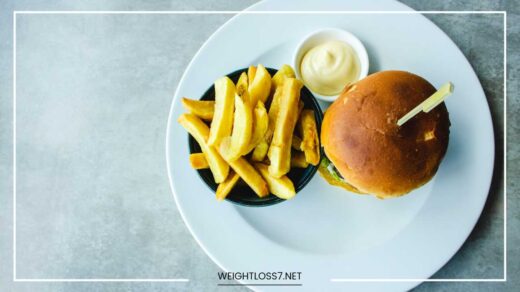How to Lose Weight Fast: A Practical Guide for a Healthier You

How to Lose Weight Fast
Shedding Pounds and Gaining Confidence: A Comprehensive Guide to Sustainable Weight Loss
Shedding weight can feel like navigating a labyrinth – filled with conflicting information, unrealistic expectations, and dead ends that lead to discouragement. But here’s the refreshing truth: sustainable weight loss is absolutely achievable, and it’s about so much more than just a number on the scale. It’s about embarking on a transformative journey towards a healthier, happier you.
This comprehensive guide equips you with the knowledge and tools you need to navigate this journey with confidence. We’ll delve into the science of weight loss, explore practical diet and exercise strategies tailored to different needs, and address the common roadblocks that can derail progress.
Most importantly, we’ll emphasize the importance of a holistic approach, where healthy habits become the foundation for a sustainable and fulfilling lifestyle.
Understanding the Science: Calories and the Bigger Picture
Weight loss boils down to creating a calorie deficit. In simpler terms, you need to burn more calories than you consume. Our bodies use calories for energy, and when there’s an imbalance, the stored energy (body fat) gets used up. There are two main ways to achieve this deficit:
- Reduce calorie intake: This can involve portion control, mindful eating, and opting for lower-calorie, nutrient-dense foods.
- Increase calorie expenditure: Exercise is key for burning calories and building muscle, which further boosts metabolism.
But it’s important to go beyond the basic calorie equation. Here are other crucial factors that influence weight management:
- Macronutrients: The balance of carbohydrates, protein, and fat in your diet plays a significant role. Protein keeps you feeling fuller for longer, while healthy fats can aid satiety and support hormonal balance. Aim for a balanced plate that incorporates all three macronutrients in appropriate ratios.
- Micronutrients: Don’t underestimate the power of vitamins and minerals! They are essential for overall health and can indirectly impact weight management by regulating hormones and supporting metabolic processes. Ensure a colorful variety of fruits, vegetables, and whole grains in your diet to get a good dose of these micronutrient powerhouses.
- Sleep: Adequate sleep (around 7-8 hours per night) is crucial for regulating hormones that influence hunger and metabolism. When sleep-deprived, your body produces more ghrelin (the hunger hormone) and less leptin (the satiety hormone), leading to increased cravings and potential overeating.
- Stress: Chronic stress can wreak havoc on your weight-loss goals. It elevates cortisol levels, a stress hormone that promotes fat storage, particularly around the belly. Practice stress-management techniques like deep breathing, meditation, or yoga to keep cortisol levels in check.
Crafting a Personalized Diet Plan for Success
Now, let’s translate this scientific knowledge into practical dietary strategies that fit your lifestyle:
- Focus on whole, unprocessed foods: Prioritize fruits, vegetables, whole grains (brown rice, quinoa, oats), lean protein sources (chicken, fish, beans, lentils), and healthy fats (avocados, nuts, seeds, olive oil). These foods are packed with nutrients, keep you feeling full, and provide sustained energy throughout the day.
- Limit sugary drinks and processed foods: These are often calorie-dense and devoid of essential nutrients. Sugary drinks like sodas, juices, and energy drinks contribute to empty calories and blood sugar spikes. Processed foods are often loaded with added sugars, unhealthy fats, and sodium, making it challenging to feel satisfied and control calorie intake. Opt for water or unsweetened tea/coffee instead of sugary drinks. Prepare meals from scratch using whole ingredients whenever possible.
- Embrace mindful eating: Pay close attention to your hunger cues. Don’t eat just because the clock strikes a certain time. Eat slowly, savor each bite, and stop when you’re comfortably full, not stuffed. Avoid distractions while eating – put away your phone and focus on the experience of nourishing your body.
- Read food labels: Be an informed consumer! Pay attention to portion sizes and serving suggestions. Be wary of hidden sugars in processed foods. Look for ingredients you can recognize and understand.
- Stay hydrated: Water is essential for various bodily functions, including digestion. It also helps with feeling full and reduces cravings. Aim to drink plenty of water throughout the day, especially before meals.
- Don’t skip meals: Regularly scheduled meals help regulate blood sugar levels and prevent overeating later in the day. Skipping meals can lead to uncontrollable cravings and impulsive snacking. Aim for 3 balanced meals and 2-3 healthy snacks per day to keep your metabolism fueled and hunger at bay.
Finding Your Fitness Groove: Creating an Exercise Routine You Love
Exercise is a crucial partner in weight loss, not just for burning calories but also for building muscle, which boosts your metabolism and helps you burn more calories at rest. Here’s how to create an exercise routine you can stick with and enjoy:
- Find activities you enjoy: This is crucial for long-term adherence. Explore different options like brisk walking, running, swimming, dancing, cycling, yoga, Pilates, or team sports. Don’t be afraid to try new things! The key is to find activities that bring you joy and keep you motivated.
- Start gradually: Don’t jump into intense workouts if you’re a beginner. Begin with manageable durations and intensity levels, like 20-30 minutes of moderate-intensity exercise 3 times a week. Gradually increase the duration and intensity as your fitness improves. Listen to your body and take rest days when needed.
- Incorporate variety: Mix things up to keep your workouts interesting and prevent plateaus. Explore different types of exercise – cardio for endurance, strength training for muscle building, and flexibility exercises like yoga or Pilates to improve range of motion and prevent injuries. Consider high-intensity interval training (HIIT) for a time-efficient workout that burns a significant amount of calories in a shorter period.
- Aim for at least 150 minutes of moderate-intensity exercise per week: This is the minimum recommended amount for weight loss and overall health benefits. You can break this down into smaller chunks throughout the week, like 30 minutes of exercise 5 days a week.
- Find a workout buddy: Having a partner can boost accountability and make exercise more enjoyable. You can motivate each other, stay on track with your goals, and make workouts more social and fun.
- Consider working with a certified personal trainer: A trainer can create a personalized exercise plan tailored to your fitness level, goals, and any limitations you might have. They can also provide guidance on proper form to prevent injuries and ensure you’re maximizing the effectiveness of your workouts.
Beyond the Scale: Embracing a Holistic Approach to Weight Loss
Focusing solely on the number on the scale can be a demotivating and limited approach to weight loss. Here’s how to cultivate a more holistic approach that prioritizes overall well-being:
- Strength training for body composition: Don’t shy away from strength training! Building muscle mass helps boost your metabolism, which means you burn more calories even at rest. Strength training also improves bone health, posture, and overall strength. You don’t need heavy weights to get started. Bodyweight exercises, resistance bands, or free weights can be effective for building muscle.
- Focus on non-scale victories: Celebrate your progress beyond the scale. Track your increasing energy levels, improved sleep quality, better mood, and increased strength or flexibility. These non-scale victories are powerful motivators and markers of your overall progress.
- Prioritize stress management: Chronic stress can sabotage your weight-loss efforts. Develop healthy coping mechanisms like meditation, deep breathing exercises, yoga, spending time in nature, or spending time with loved ones. By managing stress, you can keep cortisol levels in check and create a more favorable environment for weight loss.
- Get enough sleep: Aim for 7-8 hours of quality sleep each night. When sleep-deprived, your body produces more ghrelin (the hunger hormone) and less leptin (the satiety hormone), leading to increased cravings and potential overeating. Prioritize good sleep hygiene practices like establishing a regular sleep schedule, creating a relaxing bedtime routine, and ensuring a cool, dark sleep environment.
Conquering Common Roadblocks: Building Resilience on Your Journey
The journey to weight loss isn’t always smooth sailing. Here’s how to tackle common challenges that can derail your progress:
- Motivation dips: It’s normal to experience dips in motivation. Here are some tips to reignite the spark: Celebrate small wins, no matter how seemingly insignificant. Track your progress in a journal, using photos, or a weight-loss app (focusing on trends over daily fluctuations). Find inspiration from success stories of others who have achieved their weight-loss goals. Reward yourself for reaching milestones on your journey.
- Cravings: Cravings are a natural part of the process. Here’s how to manage them: Plan healthy snacks in advance to have readily available options when cravings hit. Keep tempting foods out of sight and readily available healthy alternatives within reach. Distract yourself with activities you enjoy when cravings arise. Drink plenty of water, as thirst can sometimes be misinterpreted as hunger.
- Setbacks: Setbacks happen to everyone. Don’t beat yourself up! View them as learning experiences. Analyze what led to the setback and develop strategies to avoid it in the future. The key is to get back on track with your next meal or workout. Don’t let one setback derail your entire journey.
- Emotional eating: Identify emotional eating triggers. Emotional eating involves using food to cope with negative emotions like stress, anxiety, sadness, or boredom. Here’s how to address it: Become aware of your emotional triggers. Keep a journal to track your emotions and what you eat. Identify patterns and connections between your emotional state and food choices. Develop healthy coping mechanisms for dealing with emotions instead of turning to food. This could include activities like journaling, talking to a trusted friend or therapist, practicing relaxation techniques like deep breathing or meditation, or engaging in hobbies you enjoy.
Seeking Support: Building Your Weight-Loss Community
You don’t have to go on this journey alone. Here are some ways to build a support system that can empower you:
- Consult a doctor or registered dietitian: A doctor can assess your overall health and provide personalized guidance based on your medical history and individual needs. A registered dietitian can create a customized meal plan that aligns with your preferences, goals, and any dietary restrictions you might have.
- Consider joining a support group: Connecting with others on a similar journey can offer encouragement, accountability, and a sense of community. Support groups can be found online, in your local community center, or through weight-loss programs. Sharing experiences and tips with others who understand your struggles can be incredibly motivating.
- Find an accountability partner: Having a friend or family member who is also working towards weight-loss goals can be a great source of motivation. You can hold each other accountable, celebrate milestones together, and offer support during challenging times.
Making Sustainable Lifestyle Changes: Building Habits for Long-Term Success
The key to lasting weight loss is building healthy habits for the long term, not just focusing on temporary fixes. Here are some tips for making sustainable lifestyle changes:
- Set realistic and achievable goals: Don’t aim for drastic overnight changes. Start with small, achievable goals that you can gradually build upon. For example, instead of aiming to lose 10 pounds in a week, aim to lose 1-2 pounds per week through healthy eating and exercise.
- Focus on progress, not perfection: There will be bumps along the road. Don’t get discouraged by occasional slip-ups. The important thing is to keep moving forward and focus on overall progress over perfection.
- Make healthy swaps: Gradually incorporate healthier alternatives into your diet. Swap sugary drinks for water, replace refined grains with whole grains, and choose lean protein sources over processed meats. These small swaps can make a big difference in your overall calorie intake and nutrient profile.
- Cook more meals at home: This gives you more control over the ingredients and portion sizes. Experiment with healthy recipes and find meals you enjoy that fit your dietary needs and preferences.
- Plan your meals and snacks: Planning meals in advance helps avoid unhealthy choices when hunger strikes. Stock your pantry and refrigerator with healthy staples to make healthy meal prep easier.
- Find healthy ways to manage stress: Chronic stress can lead to unhealthy eating habits and weight gain. Develop healthy coping mechanisms for managing stress, such as yoga, meditation, spending time in nature, or spending time with loved ones.
Remember: Weight loss is a marathon, not a sprint. Be patient with yourself, celebrate your victories (big and small), and focus on creating a healthy lifestyle that you can maintain for the long term.
By incorporating these strategies and cultivating a holistic approach, you can embark on a transformative journey towards a healthier, happier you, not just a smaller number on the scale.

















